For decades, Oscar-winning filmmaker Guillermo del Toro has been cited as an auteur whose movies often look fantastically original compared to other genre films. The Mexican filmmaker has long valued production design and the artists responsible for it, and that was the case once again with his new stop-motion animated movie Pinocchio, which is now streaming on Netflix.
Once again, del Toro worked with Guy Davis, a renowned comic book artist who has been involved with designing creatures (among other things) for the director’s films over the past decade. Davis was promoted to full-fledged Production Designer for Pinocchio, working directly with his Co-Production Designer Curt Enderle, whose background is steeped in stop-motion animation, having worked on films such as LAIKA’s ParaNorman.
Last week, Below the Line spoke with both production designers over Zoom, and they gave us yet another glimpse inside the mind of Guillermo del Toro and how they helped turn his ideas into three-dimensional sets and puppets. If there’s anyone out there who thinks that production design means more to a live-action film than an animated one, the decision by New York’s Museum of Modern Art to house an ongoing Pinocchio exhibit featuring Davis and Enderle’s sets and many of the film’s puppets should squelch that myth.
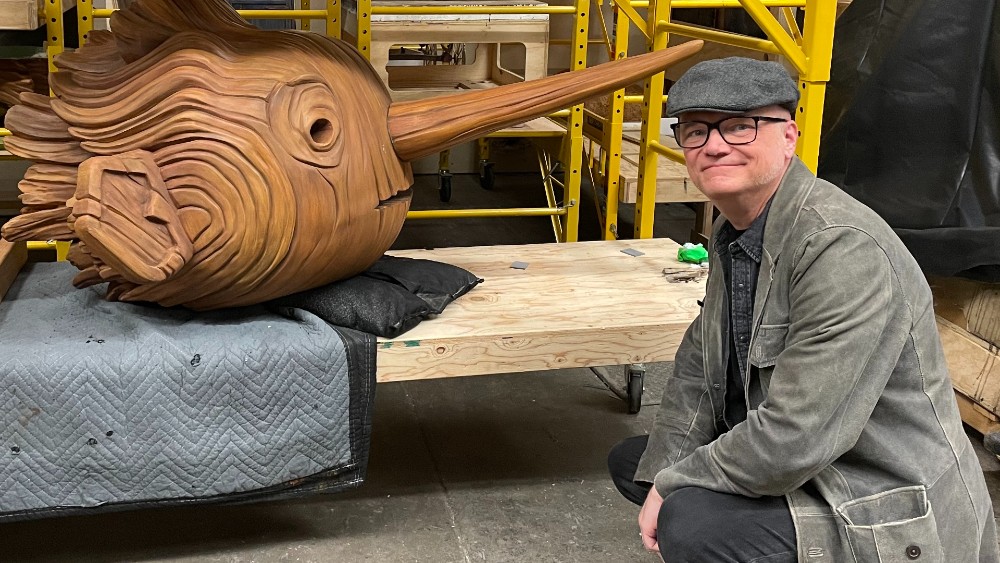
Below the Line: I want to start with Guy, mainly because I know he’s worked with Guillermo designing creatures and doing various design work for his films for some time. What led to the decision to jump into full production design and also do that with Curt? And then I’ll ask Curt for his side of the story…
Guy Davis: Sure. I’ve been working with Guillermo for a while, and actually, I was brought on to Pinocchio in 2012, during a redesign phase. I’m trying to remember the production I was on at the time with Guillermo. [He] asked me to come in [and] try my hand and doing some redesigns from where it was, bringing it more into caricature, and a different style. There was a bit of a pause on that production, and when it came up again, years later, he just said, ‘Do you want to work on this as co-production designer with another production designer,’ and it’s like, ‘Of course, thank you. That’s such a wonderful opportunity.’ It just kind of happened that way that when I came back around for this current edition in around 2018, I was offered that position along with Curt, which was my first time meeting and working with Curt, but it was a great collaboration. I learned everything I could about stop-motion from Curt, Rob, and ShadowMachine, because I’d only worked in some 2D animation and live-action before then.
BTL: What were your early conversations with Guillermo like, Curt? As Guy mentioned, he’d been trying to make this for quite a while…
Curt Enderle: I was just brought on about four years ago now. I don’t have a shorthand with Guillermo, and I think because Guy’s worked with him for over a decade at this point, there’s an ease of interpretation. Guillermo will say three words, and something will come out of Guy’s hand, and you’ll be like, ‘That’s it! Great, we can run with that.’ He has that relationship with Guillermo and is fabulous with a pen, and my background is in stop-motion, so I think it’s one of those collaborations where neither of us could have really done this job by [ourselves]. It really did take the two halves.
Stop-motion is kind of its own odd, unique requirements. I don’t have live-action experience — I just have stop-motion, and this was a way that we could work together. The first time meeting Guillermo, he came to the studio a number of times four years ago and talked to us about the project in general, in terms of what he wanted it to look like. We gave him a range of very whimsical and stylized to something less so, and we knew the character designs at that point. The level of production value, if you will, like how realized it wanted to be, and also then he gave us guidance in color. He didn’t have a finished script, but he had a partial script, and he sat down and read it to us all, and that was amazingly inspirational. You saw already the love for this story, and I think that is evident in every frame, really. His passion for this has really translated into an amazing product.
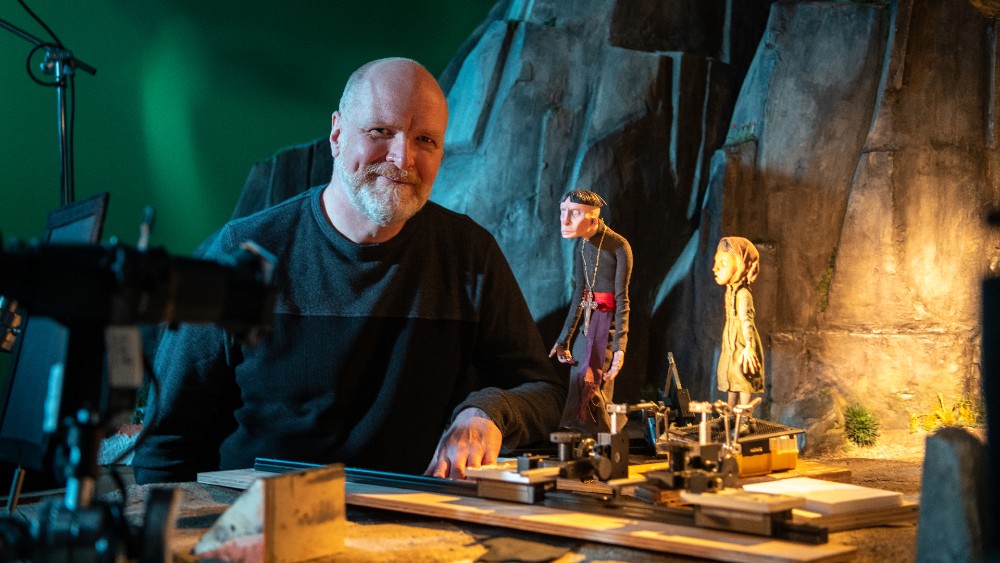
BTL: Guy, I’m curious about the first time you met Guillermo, which I assumed was through Mike Mignola, who he had already been working with for quite some time on the Hellboy movies.
Davis: Actually, I didn’t meet him through Mike at all. I was home one night, and I got a call from someone saying, ‘Please hold for Guillermo del Toro,’ and I said, ‘Okay.’ It was actually him asking me to come to work on The Hobbit in New Zealand during that time. It was a very short meeting, [with him] just saying that he liked my work and wanted me to come help out on The Hobbit, and I said, ‘Of course.’ It wasn’t something that you’d have to think about, for very long. That didn’t pan out, for one reason or another, but then afterward, even though we didn’t get to work together on The Hobbit at all, he then contacted me again for Mountains of Madness.
BTL: Which also didn’t happen.
Davis: I was starting to feel self-conscious; it was me or something. After that, Pacific Rim happened, but Mountains of Madness was the first time that we actually worked together. The collaboration was really inspiring for me, and we seemed to work together really [well], and during Mountains of Madness was when he also was starting a video game, and he asked me to then start doing designs for that. That was pretty much what started the ball rolling.
BTL: I know Guillermo has notebooks full of drawings he’s done over the years, and I’m curious how much you take from those drawings to develop them and make them more 3D. Did he already have drawings for Pinocchio in those notebooks?
Davis: His personal sketchbooks, he keeps very close to him, so you get a glimpse, but you’ve never handed the book to go through. When I started back on this in 2018, I met with Guillermo and Patrick McHale in Vancouver, and that was the very first start of the redesign phase for this version. It’s basically him, just sketching out very quickly, something he had in mind in like a notebook or on a piece of paper that was nearby or something. From there, you would get an idea of what he had, and you’d work it up, and then he’d make a note on your drawing, saying, ‘Well, no, I don’t mean that. I mean, this.’ That’s the great thing about Guillermo is that he’s very visual, and he already knows what he’s seeing in his head, and it’s getting that idea down and fleshing it out on paper. He’s hands-on in every aspect of the production. He knows what he’s seeing. He knows what he wants, from the initial design to the color choices to the performances, to the builds.
BTL: Were you guys able to work in the same location at all during that time? I know you’re in Portland, Curt, and Guy, you’re in Michigan? Would you guys come together in Portland to work on the designs during pre-production or were you already using Zoom to go through stuff?
Enderle: No, [in] the beginning, we all were in Portland, and were you here for four months, Guy? Six months?
Davis: Yeah, maybe six months I was there. I didn’t relocate, I just visited.
Enderle: The first bit, when the script was really sort of coming into this version, we were still fine-tuning some of the character designs, and we were starting the first maquettes, the three-dimensional sculpts of the various characters. It was definitely a time when a lot of things were happening, and some of it was pretty defined, and some of it was still a little bit nebulous. I think the sets and locations probably evolved more with the script over a full year, but, at that point, when Guy went onto his next project, I was still on site and was able to deal with things on a certain level here and then sort of float them back up to Guy when I was comfortable with things and get his opinion and then sort of disseminate that information back out to the team. It was really sort of carrying on that vision and honoring those lines on paper that we had to work to get at in the beginning.
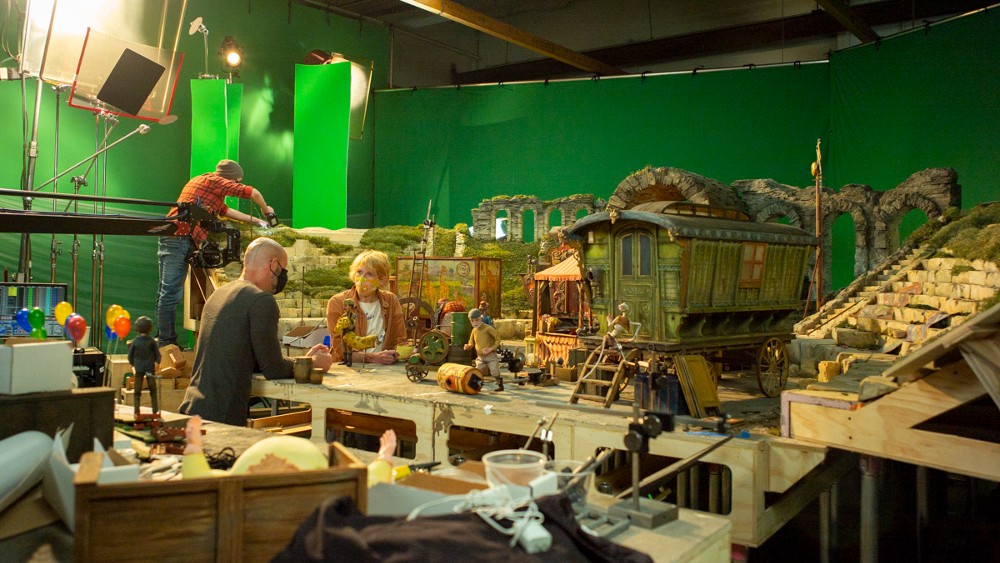
BTL: Guy, you’re kind of renowned for your creature design especially. Was creating the look for Death and Monstro and those sorts of things something you were tackling first and did Guillermo already clear ideas for those things?
Davis: I think the dogfish was originally designed during the 2012 phase along with some other things like the black rabbits — those carried over pretty good. We had other designs that were almost locked in. Huy Vu, one of our concept designers had worked on Geppetto, so we had a Geppetto, which we changed very minimally when we started again in 2018, more just to tie him into other characters, but I did passes on Gris [Grimly]’s Pinocchio, to tie it more into that look of Geppetto that we had liked. So they sort of felt part of the same world. But also aside from the monsters, I did a lot of the character designs from the Podesta and Candlewick, but obviously, Death and the Wood Sprite were a lot of fun, and those are new characters that we tackled during the 2018 relaunch of it.
BTL: Guy was talking about creating the look for the characters, and costume design is usually its own department, but in a case like this, and with puppets especially, do you work with the costume designer as well to make sure that what you draw can be realized on the puppets?
Davis: No, that was all kind of attached to the character. When I did the character design, I also did a costume pass, as far as, “this is what the coat would look like,” or “this is what the scar…” But then from there, we had Georgina Hayns, who was incredible [and] in charge of all the puppets, and she would look at that approved design, and then find the fabric that worked in scale to it. So it didn’t feel like a doll costume or something, it felt like what you would do for a live-action costume designer and distress it the same way and make it feel more realistic.
BTL: Curt, on your end of things, are you actually doing working blueprints for some of the buildings that need to be built?
Enderle: Well, there are layers of production. As production designer, I think mine were more conceptual, probably like I did a history of the town, and some other location sketches that were sort of added to the film, and then sort of ran those by Guy and Guillermo. We do have a team of in this case three draft people, so they’ll build a three-dimensional maquette to translate the two-dimensional sketch into three dimensions, and then essentially survey it, and create blueprints, plan views, elevations that they can pass off to the shops to build the structures and the walls and the terrain and things like that. You do all the steps of live action in that you have this sketch, but then you do have to translate it into an actual thing.
Davis: Curt would find amazing reference for the period. Guillermo was 100 percent wanting that reference included, because that’s what made it feel less whimsical. It wasn’t like we were making up these designs. They were based in a real history, but we still had to then take that real history and revisit it. You couldn’t just take ‘this is what a cup or a poster looked like.’ We had to take it and then twist it a little bit to match the rest of the world, so it felt like if this was the world the puppets would inhabit, this is what their cups would look like or their doorknobs or windows or what have you.
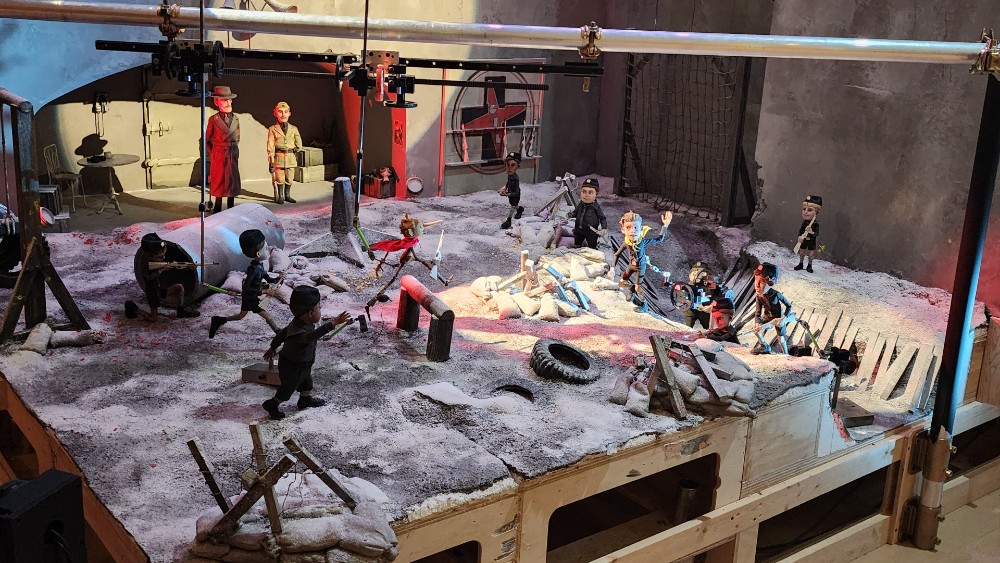
BTL: Curt, you mentioned not having done live-action production design. I would think that the biggest difference was that your carpenters were just a lot smaller for this one.
Enderle: The carpenters are regular size — their fingers are smaller. [laughs] Lots of goggles for magnification and things like that, certainly in the model shop. It’s just a slightly different skill set for those people, but they are essentially performing the same duties. We can’t go to a miniature antique store to find tools for the workbench, so everything has to have a piece of reference, and then we have to decide on the size and pass that off to the model builder and then they pass it off to the paint shop and give it a sense of history because Guillermo wanted it to feel like a place that had a story before and has a story after. We really spent a lot of time making sure that everything felt real in our world, not necessarily realistic, certainly stylized and caricatured a little bit, but had a sense of history. I think that was important for the story.
Davis: And handcrafted too. As far as all these props. Correct me if I’m wrong, Curt, but nothing was really 3D-printed at all in the sets. It was all mostly modeled by hand.
Enderle: Yeah, they would make a model of something, and then if we needed multiples, there were duplicates of the workshop, for instance. So they would make either one-offs, or if it’s something delicate, and then if it was something more robust, they could make a mold and cast up three additional ones so that they could all match. In general, we opted for the hand, so that it had a handmade feel and wasn’t too slick. There’s a lot of stop-motion animation that is quite slick in a way that you don’t necessarily know if it’s CG, or stop-motion even. Guillermo wanted it to feel like it was made by people.
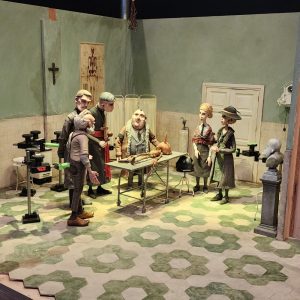
BTL: These sets must be pretty sturdy if you’re able to transport them from Portland to New York for the MOMA exhibit, so what are the model makers using to assemble them, just glue?
Enderle: They’re all people that have been doing this at various places for quite a while. We were very lucky and fortunate to be able to select the people that we wanted to work with. There were three productions going on in Portland, but yet, we kind of got the best of the best. There’s a knowledge level that comes with that, and that’s building things that are robust, because, of course, they sit in front of the camera for a long time and can’t move. The use of materials and how to emulate different textures and things like that, again, it’s a shorthand. Our Art Director, Rob DeSue has also worked with a lot of these people before, and the department heads are all people that we all know, so there’s a level of trust. They know their craft, and we’re able to just give them this set of instructions of what it needs to be and sort of check-in, and it eventually comes out the other side.
BTL: I was curious about the town. Was there a full-scale model of the entire town’s exteriors that allowed you to do some of those long shots of characters walking through it?
Enderle: There was a miniature of the town. When Pinocchio is sort of walking up the road, and you see the town very far away, that was a reduced-scale miniature. Puppets wouldn’t actually fit in, and it was foreshortened and compressed. It was almost more like a two-dimensional/three-dimensional thing, if you will. We definitely had a plan-view of the whole town. Again, we sort of developed this history from Roman times through to the present and how the population would rise and fall, and when there were earthquakes and wars and pestilence and when the wall would have been built around the town, and when the Roman temple would have been demolished and the church would have been built there. And so, we had that history.
In actuality, we built that main street corner, where they come through the gate, and then sort of walk up, but there were a number of redresses then, to sort of accomplish a lot of the other shots that needed to happen in the town. We would build specific things like the gate into that main square, and there was also an arcade that ended up in shots that weren’t used, and a couple other sets that were sort of trimmed for time. So we didn’t build the whole town. We tried to go about it efficiently, and especially in terms of exterior buildings and that look, you can have something that’s relatively generic and change out shutters and doors and add different details like a stair or something and sort of stretch your dollar a little bit that way.
BTL: I was thinking of scenes like the one with the mortician declaring Pinocchio to be dead, and you have this beautiful operating room that is literally used for one scene. Do you then redress it as some other location?
Enderle: No, that was a one-off, and because there were a lot of characters in that scene, the amount of time for animation, it was probably on stage for close to six months. It serves its purpose that way, and other things, like the church, we thought we were going to be able to redress it for the damage. Because there were so many minutes filmed in the church, over the course of production, we needed to build a duplicate church to create the damaged one. The same with the workshop. There were so many minutes in that workshop, there were three copies of that for different sequences so that they could be shooting at the same time.
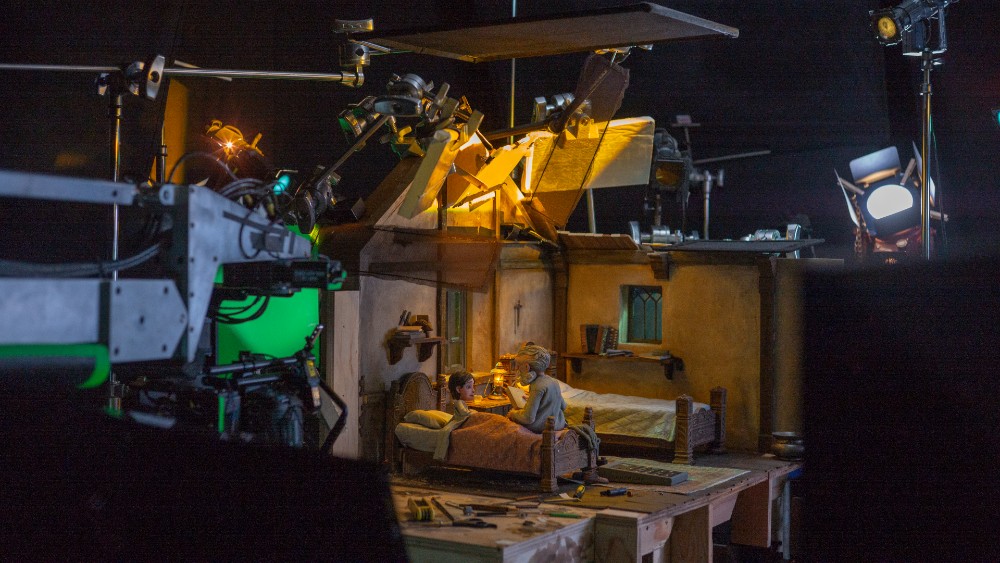
BTL: At the premiere, Guillermo mentioned a number of stages that were up and running at the same time, so does ShadowMachine have that studio spent, or do you rent out a warehouse in order to have all that going at once?
Enderle: We rented a warehouse to do this production, and the original intent was to sort of max out at about 36 stages. Usually, you have about half that many animators that you have 18 to 20 animators, and you’re taking a set down and putting a setup and getting them ready so that you hopscotch around and mesh all this production together and get those seconds out. In that same amount of space, eventually, they had 60 stages, and so they would add some back in the main building, which we didn’t intend to shoot in at all.
You start big, like the amphitheater with the carnival was a very large set, but as you get down into closer-up shots, you can strip things away. And then, sometimes you’ll divide off a section of the stage and put something else in there. That happened with a lot of the larger sets, certainly, that as we could shrink them down, then we were able to sandwich in another little thing for a couple of insert shots and stuff like that. The animator count grew to over 30, and again, you needed 60 stages so that you can have some that are done shooting and some that are starting to get ready to shoot.
BTL: Guy mentioned 3D printing earlier, so how were you using it in terms of the props or set decoration?
Davis: Well, we didn’t actually use 3D printing for props. Those were molded and cast for the most part. It was just mostly Pinocchio’s replacement head and [Count Volpe’s monkey] Spazzatura.
Enderle: The facial replacements for Pinocchio were 3D-printed, and again, that was because an earlier test from, I think, 2010, they had tried a mechanical face like the rest of the puppets, which has the paddles to move around the silicone skin. It was distorted in a way that it didn’t feel like a wooden object. The technology is now at a point where you can print out something that is consistent enough in color and looks like a hard object. That was sort of the choice that was made to also differentiate that character a little bit, that he’s not like the other puppets. Also, Spazzatura’s muzzle was used as a 3D print, because the amount of distortion would have been more than you could accomplish with a silicone skin.
You can make big shapes, you can stretch things out, but then all that stuff has to go somewhere, so you wouldn’t get any of [that] small ooze and things like that. Those two things were the 3D printing challenges in this, and occasionally, they would print out a part. Pinocchio had some 3D-printed body parts out of metal. Part of his shell was printed out in metal and certainly ball joints in his shoulders and knees, but in general, when you’re 3D printing, somebody still has to model it and then print it out and clean it up. Definitely in the model shop, we would opt to have that be a person so that it has [a] handmade feel.
Davis: Because if you 3D model it you have to model it to be handmade, and it kind of feels detached, whereas if you have someone just actually carving it or sculpting it and then casting it, it’s more of that.
Enderle: It’s more difficult to make it perfectly imperfect. If it is in a computer and perfect, then you have to go make [the] extra effort to make it imperfect.
BTL: I noticed you had six set decorators listed, so did you work very closely with them? And Guy, did your drawings have the details that the set decorators could then pick up on while dressing the sets?
Davis: The actual layout and maybe the inside of Volpe’s trailer is going to have a chair and a table and this and that. As far as a layout usually comes with the concept phase and the set design phase. From there, we have set decorators, who actually work that out, and how that’s going to look exactly, and prop makers who will say, ‘Okay, here’s a sketch of a dresser. Let’s design that to fit into the world more,’ because you can’t just immediately translate that sketch 100%. It has to be revisited as each prop.
Enderle: I think it’s all in there, referring to that sketch of the interior of Volpe’s wagon, there’s the heads of the other monkeys on the wall, the throne type of thing, the dresser, the phonograph, that’s all in that original sketch from Guy. And so then it’s really just sort of working it through a design phase, like finding some reference that it’s this type of a chair, running that through our prop designer. We have a tiny little crown on the top of it so that it feels branded for Volpe a little bit.
The six set decorators [goes] back to the 60 stages. You need that number of set decorators so that they are able to cover the number of sets and in between setups, they’ll move things around. There’s continuity, but there’s not strict continuity. It doesn’t really matter if you need something right here in frame, they’ll move things around. Rob DeSue is working with them on stage, and they’ll send an image when they’re ready to launch a shot. And then he’ll be able to say, ‘If you’ve got an hour, you can do these three things,’ but again, there’s a level of experience with those set decorators. They’ve all worked on two or three films. They know what they’re doing, and they’re working with the director and the cinematographer in the unit, sort of composing the frame. Everything is intentional in a way that we’re able to make it intentional.

BTL: Were you guys involved at all in moving the sets across the country to MOMA or is that left up to someone else?
Davis: My back’s not that strong. No, Rob [was] hands-on, not with actually moving it, but the setup there along with Frank with the lighting.
Enderle: I think there was a team of probably 12 that had gone out for a week of set desk dressing, and then there was a team prior to that, that actually dropped the sets into the space and reassembled them and did the main work. There were quite a lot of people from ShadowMachine that ended up going out to the MOMA.
I, unfortunately, didn’t get to, and the only thing that I was able to do was meet early on with Britney and Ron, the two curators, when they were first proposing this exhibit. It was literally only a year or so before it was meant to happen. We were just like, ‘These are the types of things that we have.’ I think I had 200 images, and it was like this is a digital image, this is a physical thing. This is just giving them ideas.
After they saw that, then they were like, ‘We’re just going to come and see what we want,’ so then they both traveled out and put notes on things and started figuring out when things could start moving to them. It was a bit of a logistic challenge really between the time and because we still needed things for production. We couldn’t give them puppets until we were done with the puppets.
BTL: I hope they gave you a preview of it or a walkthrough while you were in town because it’s pretty amazing.
Davis: It was incredible seeing how it was set up, and it’s an amazing exhibition of the process, which is great to see.
Enderle: It’s a crazy honor!
Davis: It’s everything, and how it makes a film.
BTL: Before I forget, was there any matte painting done for the backgrounds of the town sets?
Enderle: Well, it was digital matte painting, and it was a lot of blue screen (and green screen) for extending things. I think you kind of got a hint of that at the exhibit. The town arch was against a green screen wall, and that was exactly how it was on stage. Anything beyond that arch looking out was added digitally. Everything up the street was there physically. That part of the set did not make it to New York, but skies were added digitally, and again, a matte painter, through Mr. X [and] MPC in Toronto, mostly. So again, just trying to unify everything, and a lot of that fell to Rob DeSue, the art director, to kind of carry on the stuff that we had established while we were both there.
Davis: And treated with the same sort of handcrafted-ness. The skies aren’t crisp, smooth skies — there’s a bit of a brush to it to blend with everything else, so it’s unifying everything. It’s not trying to trick people. This isn’t a realistic live-action thing but it’s unifying that own reality that it’s set in.
BTL: Since I’ve written for Below the Line for so long, I really took it to heart when Guillermo was talking about the crafts of the movie and how those who perform those duties in animation should be getting just as much credit in the world of live-action, and I actually asked the director of DreamWorks’ latest movie about the same thing. This movie is a great example of why production design in animation is so crucial.
Enderle: It’s all the same steps. It’s this reputation it has as a babysitter, animation, as opposed to an art form. And I think, especially something like this, where it is essentially a live-action movie done by puppets. [It’s] all the same steps, and you can’t go to a location in Italy. You have to decide what color the dirt is and what grows there, and if there’s a building, what it looks like. On a certain level, it’s almost more design than a live-action film would go through, including the characters, in our case. Guy is almost completely responsible for every single character in the film, visually, so it’s a more pure form of the director being able to get what they want.
Davis: Yeah, and to be honest, having worked in live action, and now stop-motion, the steps, as far as design, everything was not done differently than live action. We did it exactly the same way. How it was created, like you said, the set is on a smaller scale, but the weathering and the distressing and all the steps that went into [it]. With Georgina, the fabrication of the puppets is the same amount of care that you would put into any sort of costume department, and the same with the sets themselves. From production design, problem-solving is problem-solving. Sometimes, it’s just different problems, but it was never treated differently because it was stop-motion.
BTL: Guy, do you think you’ll continue in this new production design career of yours and maybe continue working with Curt on other things?
Davis: I couldn’t be more thrilled and happy and proud of the entire team the way this turned out. This was such a special production to be a part of, it was [a] great time, and I would be happy to work with Curt again. We still talk to each other and are friends after working on this, so that’s a good team. [laughs]
Guillermo del Toro’s Pinocchio is currently streaming on Netflix. The exhibit “Guillermo del Toro: Crafting Pinocchio” will run at the Museum of Modern Art through April 15, 2023.





